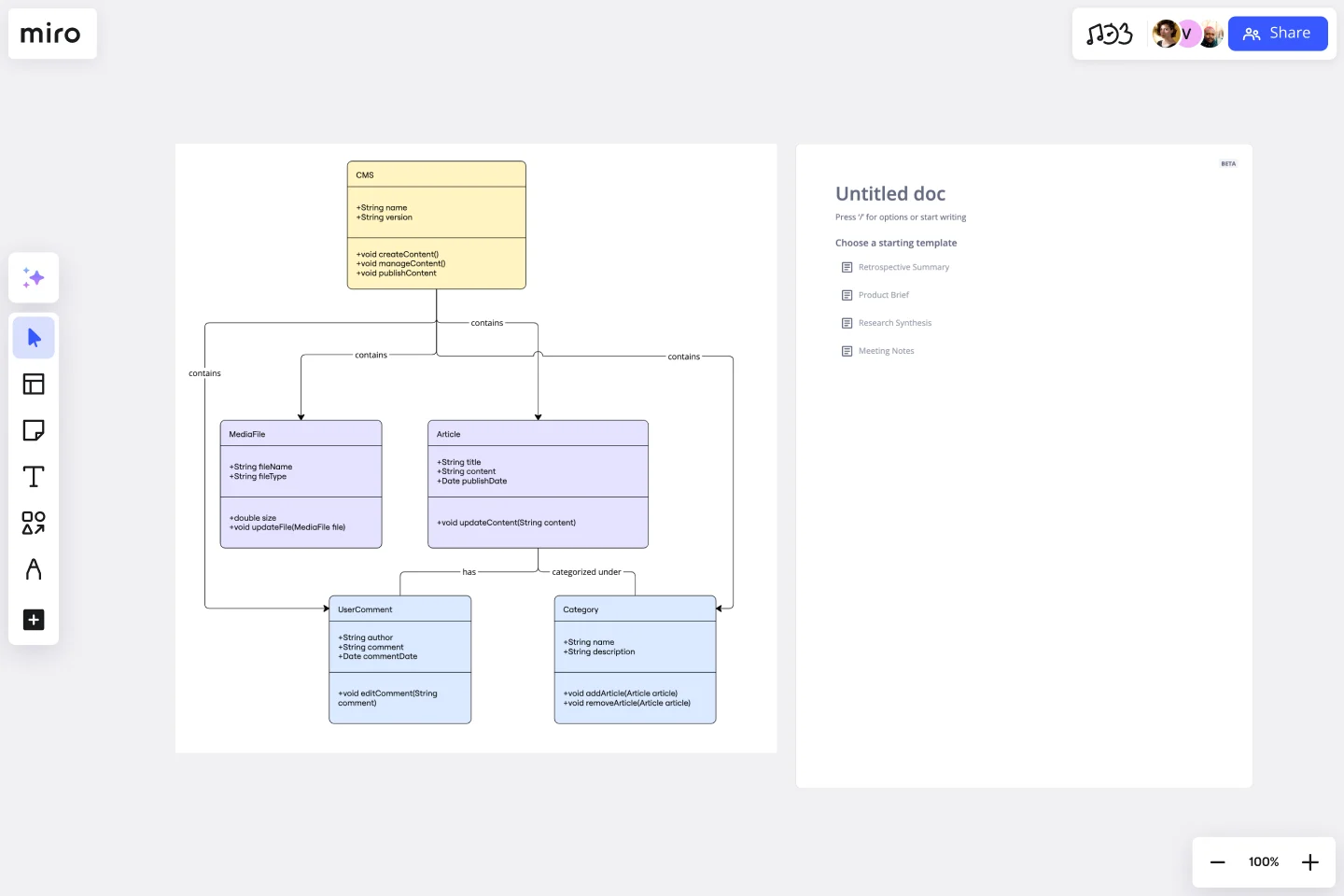UML Class Content Management System (CMS) Template
Improve the quality of the CMS architecture design with the UML Class Content Management System Template.
Available on Enterprise, Business, Education plans.
About the UML Class Content Management System (CMS) Template
The UML Class Content Management System (CMS) Template is a designed blueprint that helps visualize the structure of a CMS. This template showcases the key classes and their relationships within a CMS, illustrating how users create, manage, and publish digital content such as articles, comments, and files. It serves as a map, detailing the classes or objects in the system, their attributes, methods, and the relationships among them, including inheritance, association, aggregation, or composition. This visual representation is invaluable for understanding and documenting the architecture of a CMS.
How to use the UML Class Content Management System (CMS) Template
Customization: Once the template is added to your board, you can collaborate with your team in real-time or asynchronously to customize the diagram. This involves tailoring the classes, attributes, methods, and relationships to fit the specific requirements of your CMS.
Collaboration: Use Miro's collaborative features to brainstorm designs, leave feedback, and discuss the UML diagram with your team. The real time update capability of Miro boards ensures that everyone is always looking at the latest version of the diagram.
Use tools: For building UML diagrams from scratch or further customization, you can use Miro AI or UML shape packs available within Miro. These tools can help in automatically generating UML diagrams or adding specific elements to your template.
Review and iterate: Review the UML diagram with your team, making use of Miro's commenting and feedback tools. Iterate on the design as necessary to ensure it accurately represents the CMS architecture you are documenting.
Why use the UML Class Content Management System (CMS) Template
Using the UML Class Content Management System (CMS) Template in Miro has several advantages:
Clarity: It provides a clear and structured visualization of the CMS architecture, making it easier to understand the system's components and their interactions.
Efficiency: The template accelerates the documentation process, allowing you to quickly map out the CMS structure without starting from scratch.
Collaboration: Miro's platform is designed for seamless collaboration, making it easy for teams to work together on the UML Class Content Management System (CMS) Template. Team members can contribute, edit, and comment in real time, ensuring that everyone's insights are incorporated. This collaborative environment fosters a more inclusive and comprehensive design process.
Flexibility: The template is highly customizable, allowing teams to adapt it to their specific project needs. Whether you're working on a small-scale CMS or a complex, enterprise-level system, the template can be tailored to suit your requirements. This flexibility ensures that the UML diagram remains relevant and useful throughout the development process.
Visualization: A well-structured UML diagram, like the one provided by this template, offers a visual representation of the system's architecture. This makes it easier to identify potential issues, understand the flow of data, and communicate complex ideas to stakeholders who may not be familiar with UML notation.
Documentation: Using the UML Class Content Management System (CMS) Template helps create comprehensive documentation of your CMS's architecture. This documentation is invaluable for onboarding new team members, facilitating maintenance, and providing a reference for future development efforts.
Get started with this template right now. Available on Enterprise, Business, Education plans.
Entity–Relationship Diagram (ERD) HR Management System Template
Works best for:
ERD
The Entity–Relationship Diagram (ERD) HR Management System Template in Miro is designed to streamline the management of employee-related information and processes within an organization. This template allows for the visualization and organization of complex HR systems, making it easier to understand relationships and processes. It enables users to map out departments, positions, and employee details, including attendance records, payroll, and performance reviews.
CI/CD Pipeline Diagram Template
Works best for:
Diagramming, Development
The CI/CD template is a well-designed roadmap for software deployment that enables a smooth and automated flow from development to production. This strategic layout includes critical elements such as source code management, automation servers, container orchestration, staging environments, and the final deployment to production. One of the key benefits of using such a template is that it builds a robust deployment pipeline, which significantly reduces manual intervention and human error. By visualizing each step and integrating automation throughout, teams can achieve faster deployment cycles, ensuring that new features, updates, and fixes are delivered to users promptly and reliably. This enhanced pace does not compromise quality, as the template inherently supports continuous testing and quality assurance, ensuring that each update is quick but also secure and stable before it is delivered to the end user.
Agile Product Roadmap
Works best for:
Roadmap, Planning, Mapping
The Agile Product Roadmap template enables teams to visualize and communicate the strategic direction of their product development in an agile environment. It allows for flexibility and adaptation to changing requirements while providing a clear overview of priorities and timelines. By incorporating feedback loops and iterative planning, teams can ensure alignment with stakeholder expectations and deliver value incrementally.
English Grammar Timeline Builder
The English Grammar Timeline template helps you map out the progression of grammar concepts over time. This is a great tool for educators and students to visualize the sequence and relationship between different grammar topics, making learning and teaching more effective.
Recruitment Strategy Roadmap
Works best for:
Roadmap, Planning, Mapping
The Recruitment Strategy Roadmap template helps organizations plan and execute their talent acquisition initiatives effectively. It provides a structured framework for identifying hiring needs, sourcing candidates, and evaluating recruitment channels. By aligning recruitment efforts with business objectives, organizations can attract and retain top talent, driving organizational growth and success.
Sprint Planning by Piera Mattioli
Works best for:
Planning, Strategy
Sprint Planning Template helps you organize and plan your sprints effectively. It allows you to set goals, allocate tasks, and track progress, ensuring your team stays focused and meets sprint objectives. Perfect for agile teams.
